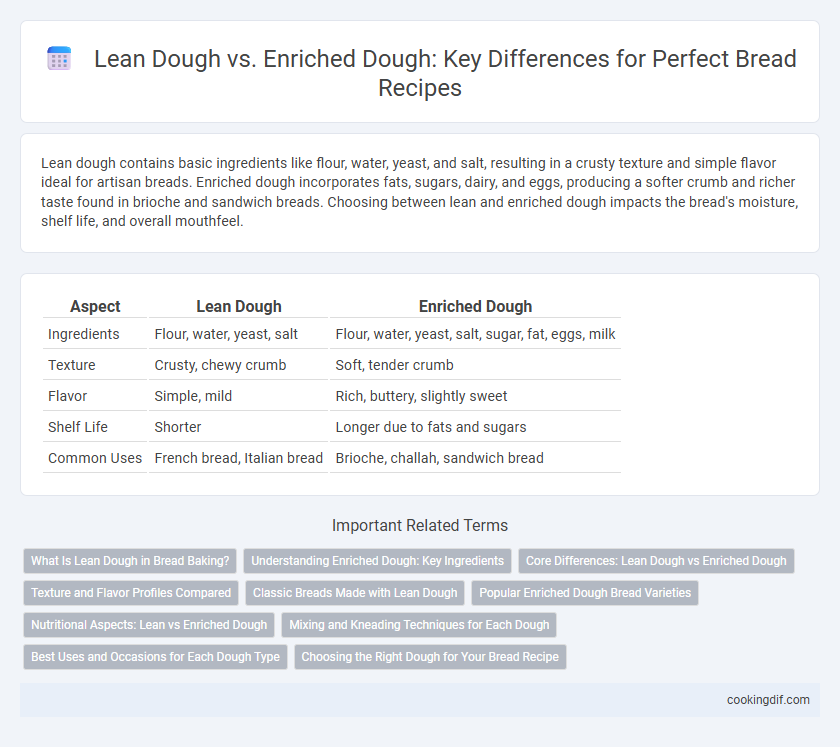Lean dough contains basic ingredients like flour, water, yeast, and salt, resulting in a crusty texture and simple flavor ideal for artisan breads. Enriched dough incorporates fats, sugars, dairy, and eggs, producing a softer crumb and richer taste found in brioche and sandwich breads. Choosing between lean and enriched dough impacts the bread's moisture, shelf life, and overall mouthfeel.
Table of Comparison
| Aspect | Lean Dough | Enriched Dough |
|---|---|---|
| Ingredients | Flour, water, yeast, salt | Flour, water, yeast, salt, sugar, fat, eggs, milk |
| Texture | Crusty, chewy crumb | Soft, tender crumb |
| Flavor | Simple, mild | Rich, buttery, slightly sweet |
| Shelf Life | Shorter | Longer due to fats and sugars |
| Common Uses | French bread, Italian bread | Brioche, challah, sandwich bread |
What Is Lean Dough in Bread Baking?
Lean dough in bread baking refers to a basic mixture of flour, water, yeast, and salt without added fats, sugars, or dairy. This type of dough produces crusty, chewy bread with a crisp exterior and open crumb texture, commonly found in artisan breads like baguettes and ciabatta. Lean dough emphasizes fermentation and gluten development, resulting in a lighter, less sweet loaf compared to enriched dough varieties.
Understanding Enriched Dough: Key Ingredients
Enriched dough contains key ingredients such as butter, eggs, milk, and sugar that increase moisture, tenderness, and flavor, differentiating it from lean dough. These additions contribute to a softer crumb, richer taste, and extended shelf life, making enriched dough ideal for brioche and challah bread. The higher fat and sugar content also promotes a golden crust and enhances browning during baking.
Core Differences: Lean Dough vs Enriched Dough
Lean dough contains minimal ingredients, primarily flour, water, yeast, and salt, resulting in a lighter, crustier bread with a chewier texture. Enriched dough incorporates fats, sugars, eggs, or dairy, producing a softer, richer, and more tender crumb with enhanced flavor and extended shelf life. These core differences affect dough hydration, fermentation time, and final bread characteristics like moisture, color, and volume.
Texture and Flavor Profiles Compared
Lean dough, composed primarily of flour, water, yeast, and salt, results in a chewier texture with a crusty exterior and a more straightforward, slightly tangy flavor from fermentation. Enriched dough incorporates ingredients like butter, eggs, milk, and sugar, producing a softer, tender crumb and a richer, sweeter taste profile with a more complex mouthfeel. The fat and sugar in enriched dough interfere with gluten development, yielding a lighter, fluffier bread compared to the denser, more rustic texture of lean dough.
Classic Breads Made with Lean Dough
Classic breads made with lean dough, such as baguettes, ciabatta, and sourdough, rely on simple ingredients like flour, water, yeast, and salt, resulting in a crusty exterior and chewy crumb. Lean doughs contain little to no fat, sugar, or dairy, which enhances gluten development and promotes a more rustic texture and flavor. These breads typically ferment longer, allowing natural flavors to deepen without the sweetness or softness found in enriched dough varieties.
Popular Enriched Dough Bread Varieties
Popular enriched dough bread varieties include brioche, challah, and cinnamon rolls, each featuring higher levels of butter, eggs, and sugar compared to lean dough breads. These ingredients contribute to a richer flavor, softer crumb, and extended shelf life. Enriched doughs are favored in artisan and sweet bread recipes due to their tender texture and enhanced taste profile.
Nutritional Aspects: Lean vs Enriched Dough
Lean dough, primarily composed of flour, water, yeast, and salt, offers a lower fat and calorie content, making it a healthier choice for calorie-conscious individuals. Enriched dough contains added fats, sugars, and dairy or eggs, which increase its levels of vitamins, minerals, and calories, providing a richer taste and enhanced nutritional profile. The presence of these added ingredients in enriched dough contributes to higher energy density and can improve the bread's texture and shelf life.
Mixing and Kneading Techniques for Each Dough
Lean dough requires intensive mixing and vigorous kneading to develop a strong gluten network essential for its chewy texture, using techniques like the stretch-and-fold method. Enriched dough benefits from gentler mixing and extended kneading times to fully incorporate fats, sugars, and eggs, ensuring a tender crumb and smooth consistency. Proper kneading techniques tailored to each dough type optimize gluten formation and dough elasticity, crucial for the bread's final structure and crumb quality.
Best Uses and Occasions for Each Dough Type
Lean dough, composed primarily of flour, water, yeast, and salt, is best suited for crusty breads like baguettes and sourdough, ideal for sandwiches and casual meals. Enriched dough contains fats, sugars, and dairy, making it perfect for softer, sweeter breads such as brioche and challah, commonly enjoyed during festive occasions and breakfast. Selecting lean dough enhances chewy textures and a robust crust, while enriched dough yields tender crumbs and rich flavors suited for special celebrations.
Choosing the Right Dough for Your Bread Recipe
Lean dough contains only basic ingredients like flour, water, yeast, and salt, resulting in a crusty texture and light crumb ideal for artisan and rustic breads. Enriched dough incorporates fats, sugar, dairy, and eggs, creating a softer crumb, richer flavor, and extended shelf life suitable for brioche, challah, and sandwich breads. Selecting the right dough depends on desired bread characteristics, baking method, and recipe purpose, balancing texture and taste preferences.
Lean Dough vs Enriched Dough for bread recipes Infographic

 cookingdif.com
cookingdif.com